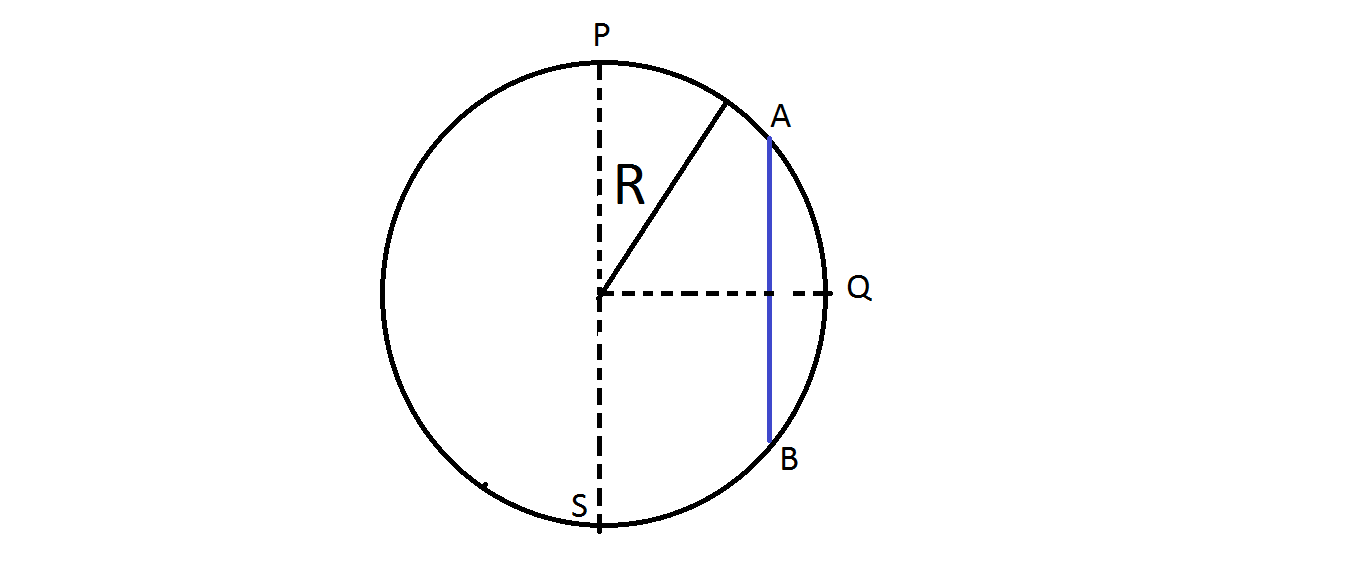JEE Advanced Mechanics Problem

In the above diagram, a rod A B of mass m and length L is held such that the length of the rod is symmetric in semi-circle (massless) P Q S about P . Now, the rod is left.
Find the velocity of end B when the center of rod reaches S .
Round your answer to the nearest integer
Details and Assumptions :
-
Radius of fixed vertical circle (frictionless), R = 1 0 m .
-
Length of rod, L = 2 1 9 m .
-
g = 1 0 m/s 2
The answer is 15.
This section requires Javascript.
You are seeing this because something didn't load right. We suggest you, (a) try
refreshing the page, (b) enabling javascript if it is disabled on your browser and,
finally, (c)
loading the
non-javascript version of this page
. We're sorry about the hassle.
1 solution
@Vedant Jadhav , The instantaneous axis of rotation of rod is the center of circle. By energy conservation between Q and S, mgR=1/2(I)(w^2). here (w is angular velocity of rod when its center reaches at S) and I is the moment of inertia of rod about the center of Circle perpendicular to the plane of circle, which yields velocity of B as 18.13 m/s. Where am i wrong?
Log in to reply
Here, as you have considered, the instantaneous axis of rotation of the rod will always be the centre of the rod. So the moment of inertia I will be (ml^2)/12 + mr^2. After calculating, we get this equal m x 262/3. Also, the potential energy is conserved with respect to IAOR. So mgR = (1/2) x I x (w^2). So on substituting the values, we get, w = 1.513 rad/s. Now vB is w x R. So, vB = 1.513 x 10. So we get vB approximately 15m/s.
Log in to reply
I am confused. Shouldn't change in potential energy be mg*sqrt(R^2-l^2/4)?
Log in to reply
@Jacob Sony – Man the center reaches at S, the distance of S and center of circle is R. so δ U = m g R
@Vedant Jadhav you have applied energy conservation wrongly. The total kinetic energy of the rod is K = 2 1 m v 2 + 2 1 1 2 m l 2 ω 2 The loss in potential energy is − Δ U = m g r ; r = 9 meter Further using contact constraint b/w rod and sphere gives v = 9 ω .
Solving K + Δ U = 0 yields ω = 1 3 1 2 7 0 which means that V B = v 2 + 1 9 ω 2 = 1 4 . 3 5 m/s .
The correct answer is 14. @Steven Chase
The kinetic energy will be sum of translational and rotational when the rod is performing rotation as well. In this case it is not.
Log in to reply
What? The kinetic energy of rod is actually sum of (kinetic energy of cm) + (kinetic energy about the cm). What you have written as 1/2 mv^2 is only kinetic energy of the cm. The ω used by you is about cm, so 1/2 I w^2 term will definitely come.
@Vedant Jadhav If you want to clear your this doubt, try solving IE Irodov problem 1.267. You will definitely know then.
Read the solution carefully. I've specifically mentioned the w used there is the angular velocity of circular motion of the rod, not rotational motion.
Log in to reply
Just think about it. If the rod does not have any ω about its center, and at this instant it is moving horizontally to left then the point in contact with ring will have a velocity component normal to the surface, right? This means the point will go through it. Can this happen? No
Please just try Irodov problem 1.267. You will understand. See it here https://jeemain.guru/pdfdownload-problems-in-general-physics-i-e-irodov/
Here we assume that there is no friction between the rod and the circle and the rod is always in contact with the circle. Now, we can see that on the COM only one force is acting that is the weight of the rod. So the COM of rod performs circular motion around the centre of the circle. Radius of circular motion is given by r = R 2 − l 2 / 4 = 9 . Now the velocity of COM when it reaches the axis on which point S lies, its velocity is given by energy conservation. 2 1 m v c 2 = m g r = > v c = 2 g r . Substituting the values we get v c = 3 2 0 . Now the rod is a rigid body and the angular velocity of the COM of the rod is the angular velocity of all the points on the rod. Therefore, w c = r v c = > w c = 3 2 0 . Now let's take velocity at point B as v 1 when the centre of rod reaches point S . Therefore as stated above w is same for all points on the rod. Therefore w c = w B . The velocity at B is tangential to the circumference and the radius of circular motion is equal to R = R a d i u s o f C i r c l e = 1 0 . Therefore w B = R v 1 . Which implies that w c = R v 1 . On substituting the values we get v 1 = 3 1 0 2 0 = 1 4 . 9 0 7 Rounding up to the nearest integer, v 1 = 1 5 m s − 1 .